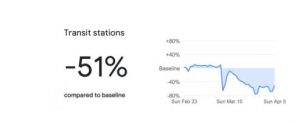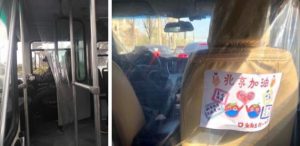The Second Line
How our Public Transport can Prevent, Protect and Survive a global Pandemic
By Mohamed Hegazy, May 3, 2020
Transit workers are essential to keep our cities functioning during the current Coronavirus Pandemic, and afterwards. They shuttle essential workers – like doctors, nurses, and emergency respondents – to and from work. Yet, transit workers are risking their health and livelihoods during COVID-19. Their risk is our risk. Public Transport operators1 need to do more in the current early stage to protect their employees, their passengers and ensure long-term business continuity. Public Transport regulators2, lead by the MoT, should lay out a plan to help the Taxi, Ridehailing and Paratransit transport sector (i.e. Microbuses, service, etc.) deal with the pandemic.
We are still in the early stages of an acute short-term crisis, imposing a limited set of social distancing measures. In the medium-term (1–2 years) we will need to develop strategies to gradually lift these measures and return to normality. For the next 18 months, outbreaks are likely to follow any easing of social distancing, prompting the reinstatement of such measures (Figure 1) (Kissler et al., 2020)3.

A longer-term approach to managing the public transport sector’s response to the COVID-19 epidemic is therefore necessary. This approach needs to include multiple measures, moving beyond hygiene-related precautions to include engineering and administrative controls and the expansion of all measures to the informal transport sector.
Preventing the spread of COVID-19

Public transport systems such as buses and trains are high-risk environments for COVID-19 transmission due to heavy concentrations of people in a confined space, limited access control4 to identify potentially sick persons, and importantly, a number of surface touch points such as ticket machines, handrails, and doorknobs (UITP, 2020).
Most interventions in Egypt have focused on preventing virus spread within vehicles. The stay-at home guidance reduced travel demand substantially: Aggregated, anonymized data from Google Maps
shows patronage of transit stations has dropped by 65% in Cairo,
58% in Giza and 48% in Qalyubia (Figure 2).

Public transport operators further adopted a number of environmental hygiene measures such as cleaning and disinfecting stations, vehicles, and workplaces to minimize surface contamination (Figure 3).
The MoT has tried to limit overcrowding by increasing the frequency of Cairo Metro services to enable social distancing, while some private smart microbus services limit the number of seats sold per vehicle to reduce vehicle occupancy. In South Africa, for example, the state set a ceiling of 70% passenger occupancy in microbuses, while Kenya limited occupancy to 30%.
Protecting transport workers from COVID-19
Bus drivers, terminal workers, and metro employees are front-line workers who experience high levels of contact with numerous individuals every day. They are exposed to a very high risk of infection and may act as unknowing vectors for the virus. In New York City, at least 41 transit workers have died and more than 6,000 have fallen sick or self-quarantined (Goldbaum, 2020). The coronavirus has caused crew shortages and extensive subway delays, and forced a capacity drop of 40%. In London, 15 transit workers have died from COVID-19. Similar losses have been reported in most other major cities affected. These risks are further elevated in Egypt due to:
- High levels of long-term, occupational exposure to ambient air pollution, which is associated with adverse health outcomes; thus, drivers are a high-risk factor population for respiratory diseases like COVID-19 (Lawin, et al., 2018; Xiao, et al., 2020),
- Ticket sales and inspection are almost exclusively manual processes.
- High levels of crowding in bus terminals and on vehicles is the default, as are tight seating arrangements in the paratransit sector.
Worker protection interventions in Egypt have so far been limited to formal operators and focus on hygiene promotion: The CTA has instituted some personnel protection measures such as distributing masks and gloves to its workforce, as well as administrative controls such as providing regular temperature monitoring. The Cairo Metro has mandated that workers regularly wash their hands, at least once every 2 hours (Youm7, n.d.).
Protecting workers’ livelihoods and ensure industry survival
Public transport is facing a dual challenge to its business model. First, it will experience a sharp drop of revenue due to the decline in overall transport demand and social distancing measures implemented within vehicles (e.g., maintaining minimum distance). For example, Mwasalat Misr indicated an 85% drop in its daily revenue from pre-pandemic levels (Rabei, 2020). Second, business expenses will increase in order to finance environmental hygiene measures and the procurement of personal protection equipment. The fuel pricing committee recently cut fuel prices marginally, despite a steep drop in international energy prices. Resulting savings are intended as a buffer to deal with COVID-19-related repercussions and a hedge against expected future fuel price increases.
Ensuring service continuity in the short run is paramount, particularly as formal operators could potentially face debilitating staff shortages due to worker sickness, quarantine, or absenteeism. To date, no dedicated funding has been guaranteed to formal operators to help them weather the extraordinary storm. The government has promised LE500 per month for three months for workers in the informal sector, which could include some informal transport workers who meet eligibility criteria, but there seem to be no continuity plans for the paratransit sector in place. Localized full lockdowns, such as in Kerdasa, further prevent transport workers from working. Ensuring industry survival and adaptability over the medium and long run is therefore essential, and long-term measures are required to increase system resilience.
What next?
Imagine the following scenario: Some transit workers start getting sick. They start infecting colleagues, and potentially passengers. Panic sets in among the workforce. Some workers self-quarantine, effectively stopping work and disrupting service provision. Limited service leads to dangerous overcrowding, delays, and loss of confidence of the system. Those who can, stop using public transport entirely, threatening the system over the longer run. A vicious cycle sets in.
To fully achieve its purpose and prevent the further spread of infection, the public transport sector’s response to the COVID-19 epidemic requires a number of measures necessary for the safety of its employees and commuters, and to ensure short-term business continuity and long-term industry survival. These include:

- Implement engineering controls to separate workers from potential contamination (Figure 4) (Ibold et al., 2020). Examples include installing protective sheets separating the driver from passengers, or plexiglass barriers to separate ticket sellers from passengers.
- Expand administrative controls to enable early detection of infection among transport workers. This includes multiple measures: an obligatory daily symptom survey and temperature reading for all staff, as done in the UK and US (Halbfinger, 2020); complete distancing of staff between shifts; replacement of the entire shift team if one staff member tests positive (done in South Korea); and issuance of personal protective equipment and vitamin C tablets to staff (done in Singapore).
- Expand measures to the informal sector: A transport sub-committee should be established by the MoT in tandem with the Ministry of Health to examine, monitor, and report on COVID-19 updates or related incidents and to devise strategies to ensure that the same measures are expanded to the informal transport sector.
Globally, one important trend is apparent during the COVID-19 pandemic: Commuters are increasingly choosing to walk and cycle to avoid public transport and ride-hailing (Hu, 2020; Laker, 2020). Such active travel enhances personal health and thus increases immunity against diseases. It is further incentivized in these extraordinary times by the marked decrease in ambient air pollution levels and the clear, blue skies. Street redistribution measures that re-allocate road space from cars to pedestrians and cyclists have proliferated in North America, Latin America, and Europe (Streets For All). For example, a network of emergency bikeways was set up in Bogota to relieve congested public transport.
COVID-19, like terrible diseases before it, will pass. Indeed, fighting the cholera epidemic decimating 19th-century London led to the emergence of epidemiology and the engineering marvels of the sewage system. As we retrofit our transit system to live through the next two years, we have a unique opportunity to enhance industry management, transform the informal transit sector, and re-think road space to enable a virtuous cycle towards a more equitable and sustainable transport system in the long term.
References
- Goldbaum, C. (2020, April 8). 41 transit workers dead: Crisis takes staggering toll on subways. The New York Times.
- Halbfinger, D. (2020, April 1). How are you feeling? Surveys aim to detect covid-19 hot spots early. The New York Times.
- Hu, W. (2020, March 14). A surge in biking to avoid crowded trains in N.Y.C. The New York Times.
- Ibold, S., Medimorec, N., Wagner, A., & Peruzzo, J. (2020, April 3). The COVID-19 outbreak and implications to sustainable urban mobility – Some observations. Transformative Urban Mobility Initiative (TUMI).
- Kissler, S., Tedijanto, C., Goldstein, E., Grad, Y., & Lipsitch, M. (2020). Projecting the transmission dynamics of SARS-CoV-2 through the post-pandemic period. MedRxiv. https://www.medrxiv.org/content/10.1101/2020.03.04.20031112v1
- Klopp, J. (2020, April 13). Op-ed: This crisis will end — Our fight against cars is only beginning. Streetsblog New York City.
- Laker, L. (2020, April 11). World cities turn their streets over to walkers and cyclists. The Guardian.
- Lawin, H., Ayi Fanou, L., Hinson, A.V., Stolbrink, M., Houngbegnon, P., Kedote, N.M., Fayomi, B., Kagima, J., Katoto, P., Ouendo, E.M.D., & Mortimer, K., (2018). Health risks associated with occupational exposure to ambient air pollution in commercial drivers: A systematic review. International Journal of Environmental Research and Public Health 15(9).
- Rabei, F. (2020, April). Mwasalat Misr: A 95% decrease in number of riders and working one shift due to COVID-19. Alborsa. [In Arabic].
- Streets For All. (n.d). Mobility and open space access in Los Angeles during COVID-19. Streets For All.
- UITP. (March 2020). Public transport authorities and COVID-19 response from the front line.
- Wu, X., Nethery, C. R., Sabath, M. B., Braun, D., & Dominici, F. (2020). Exposure to air pollution and COVID-19 mortality in the United States. MedRxiv.
- Youm7. (2020, March 29). Subway: Sterilization of employees’ hands every two hours, at most . Youm7. [In Arabic].
- Public transport operators include the ENR (commuter rail), the EMC (the Cairo Metro), and the CTA/APTA (public buses in Cairo and Alexandria), as well as all private operators of buses or smart microbus services.
- Public transport regulators include the MoT, particularly the newly established Land Transport Regulatory Authority (LTRA), the governorates, the Ministry of Interior, and any other public body that licenses public transport services.
- The authors conclude: “Intermittent social distancing can prevent critical care capacity from being exceeded but such measures may be required for 12-18 months. Depending on R0 and the amount of seasonality, social distancing must be ‘on’ for as little as 25% but up to 70% of the time.”
- Access control means controlling who can access public transport (i.e., ride buses or enter a Metro station). It could be used to screen potentially sick passengers, as with air travellers entering a country who have their temperature read.
